The Crew: Mission Deep Sea Review
Deep beneath the waves, where silence reigns and communication is a luxury, a group of skilled divers must work together without saying a word. Welcome aboard The Crew: Mission Deep Sea, a cooperative card game that takes players on a thrilling series of missions under extreme pressure—both metaphorical and atmospheric. In a world of noisy board games with big plastic minis and endless expansions, The Crew stands out by doing more with less: just a simple deck of cards, a handful of task objectives, and a brilliant twist on traditional trick-taking mechanics.
As the spiritual successor to The Crew: Quest for Planet Nine, Mission Deep Sea refines and enhances the experience. It challenges players to work together through limited communication and escalating complexity. And yet, it remains strikingly approachable—even for those unfamiliar with the trick-taking genre.
With its streamlined rules, elegant presentation, and near-infinite replayability, The Crew: Mission Deep Sea is more than just a clever card game. It’s a masterclass in modern cooperative design, offering rich depth and emergent moments in just about 20 minutes per dive.
Overview:
Complexity: Light-medium
Player Count: 2–5 players
Playtime: ~20 minutes
Core Mechanics: Cooperative play, trick-taking, limited communication, variable mission goals
Theme: Deep-sea exploration
Let’s head down to the depths and speak to the captain of this underwater expedition: The Crew itself.
The Crew: How to Play
Me: Welcome aboard, The Crew: Mission Deep Sea. It’s a pleasure to have you with us today. The underwater tension, the silence, the sense of coordination under pressure—it’s a thrilling setup. Could you walk our readers through what it’s like to play your game?
The Crew: Aye, gladly. Buckle up and check your oxygen tanks—this isn’t your average dive.
I’m what you might call a cooperative card game. But not the loud, shouty kind. I’m all about silent trust, unspoken understanding, and the subtle language of play. You and your fellow divers—two to five of you—are dropped into a series of increasingly difficult missions. Each one is a puzzle, a challenge that asks not what you know, but how well you understand your team.
Now, let’s talk mechanics. I run on a tried-and-true engine called trick-taking. It’s a card game format that’s been honed over centuries—legendary in the form of Bridge. Here, each player is dealt a hand of cards in colored suits, numbered 1 to 9. When a player plays a card, they lead the trick. Everyone else must follow suit if they can. The highest card in that suit wins. Simple, but layered.
But here’s the twist. You’re not just trying to win tricks—you’re trying to fulfill very specific tasks. Maybe someone needs to win the green 4. Maybe the yellow 8 must be the third trick played. The tasks vary, and they get delightfully tricky as the campaign dives deeper.
And no talking. That’s right. Once the round begins, there’s no table talk, no nudging, no Morse code blinking. All you get is one communication token, once per round. You can place it on a card to say: “This is my highest,” “my lowest,” or “my only” card of that suit. It’s a lifeline—but a slim one.
Add to that a mission log filled with escalating challenges, and you’ve got a game where every decision matters and every hand of cards is a silent negotiation under pressure.
Now, are you ready to submerge?
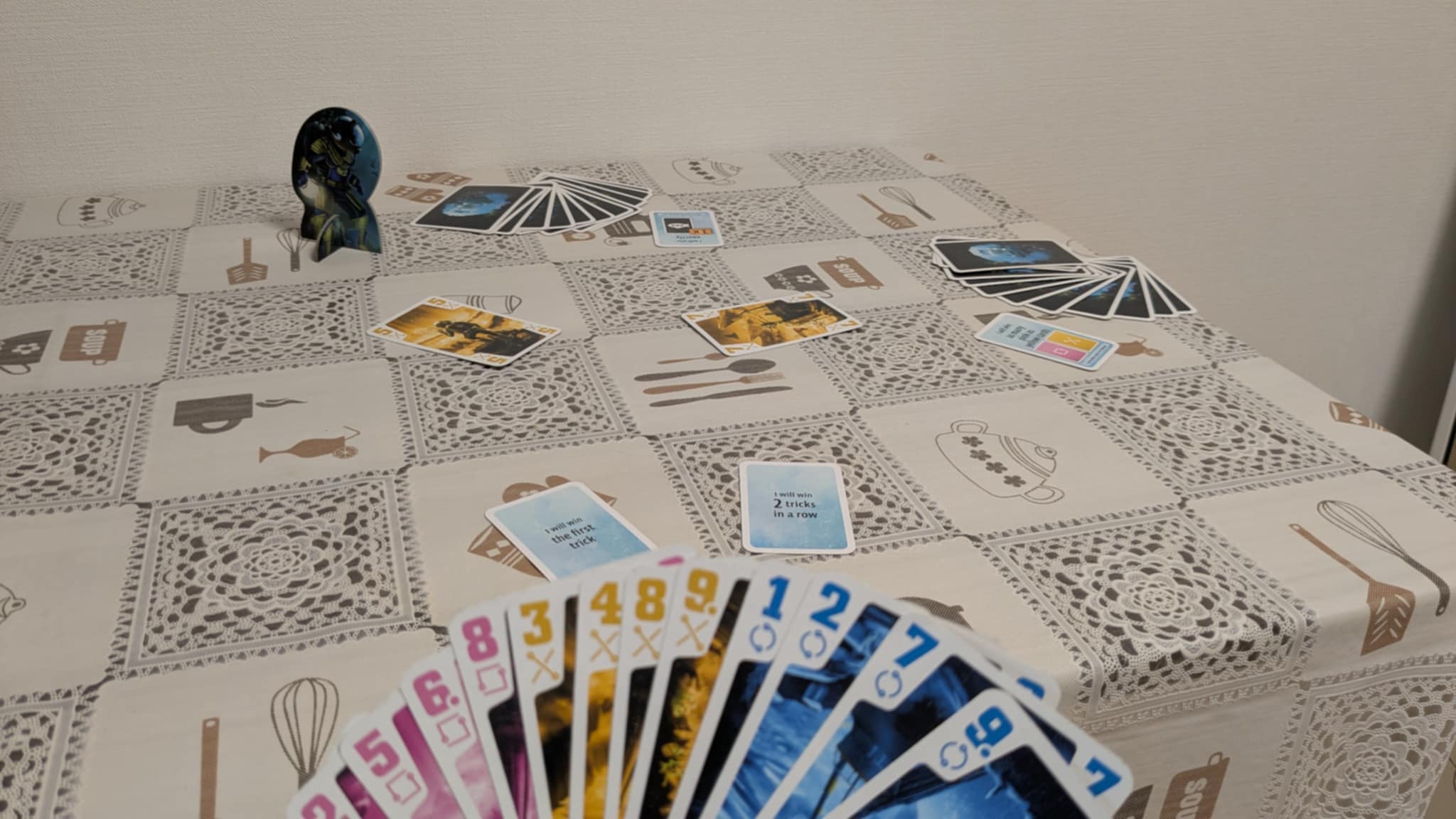
The Trick-Taking Core of The Crew
Me: That was a great briefing, Captain. Now that we’ve got a feel for how your missions run, let’s dive into the heart of your operations—your trick-taking mechanic. How do you make such an old-school card game format feel so fresh and essential?
The Crew: Ah, now that’s the soul of the operation, isn’t it? Trick-taking has been around longer than I’ve had ballast tanks. But what I do differently is why you’re taking those tricks, and how you make decisions without saying a single word.
Once you’re underwater, radio silence kicks in. No chatter, no discussion—just careful observation. That silence turns every card play into a statement, a question, or a plea. You start asking, “Why did they lead with that yellow 5?” or “Are they baiting out a suit?” You’re reading between the lines of every card.
Me: So, you’re not just playing the cards—you’re listening to them?
The Crew: Exactly. I turn card play into conversation. Every mission becomes a subtle negotiation through gameplay. And thanks to the structure of trick-taking—especially one as precise and balanced as what Bridge has honed over centuries—you get a rich language without words.
Your crew has to learn each other’s rhythms. You become attuned to hesitation, boldness, missteps. It’s quiet drama, like sonar pings in deep water—small signals, huge consequences.
Me: That’s fascinating. So the pressure isn’t just from the mission—it’s from constantly trying to interpret your team?
The Crew: Always. And the deeper you go, the more that pressure builds. Just like the sea.
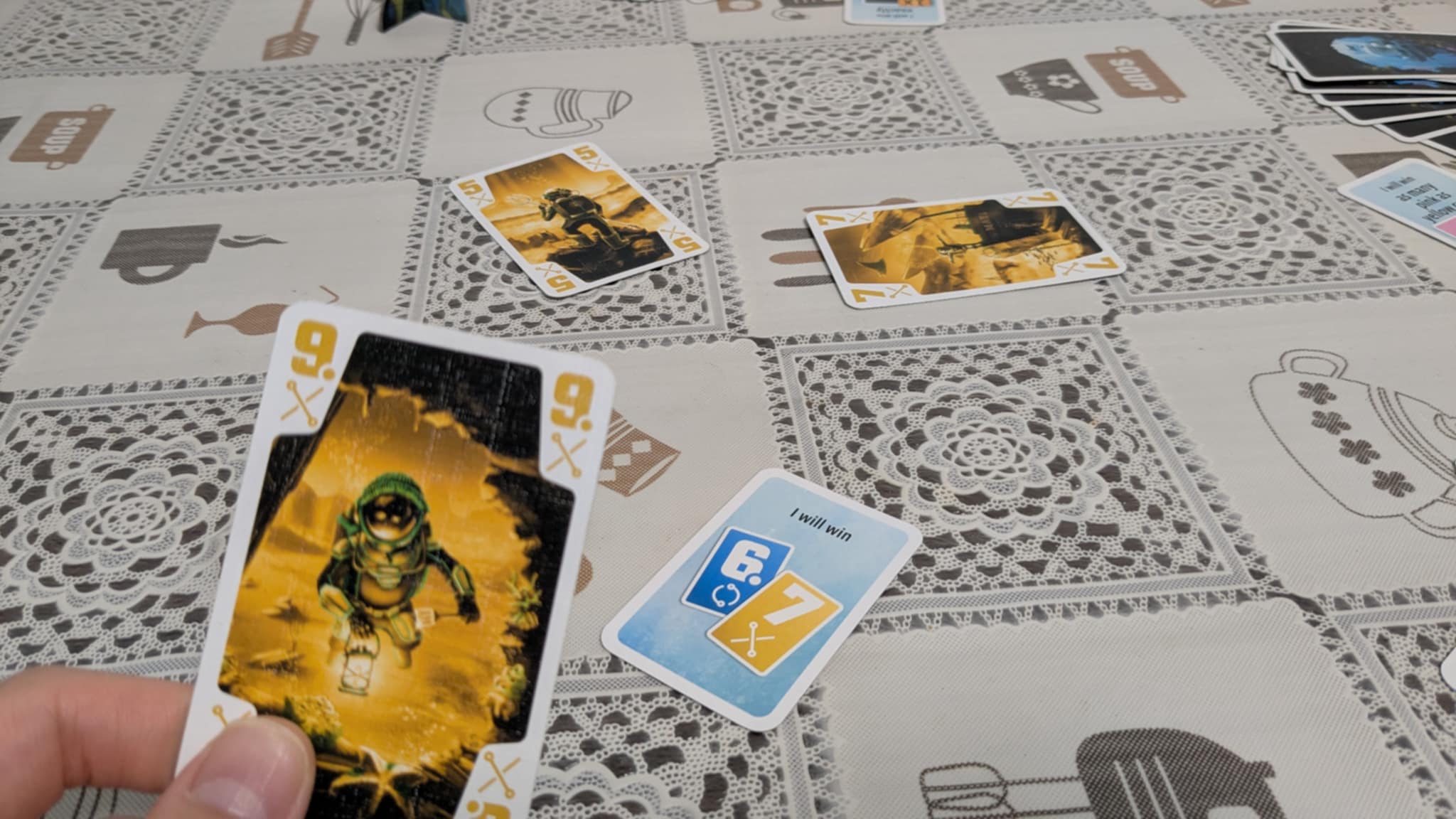
Nuanced Depth in Every Mission
Me: Captain, you’ve mentioned how your missions are built on trick-taking mechanics and silent teamwork. But how deep does that really go? Can you give me a concrete example?
The Crew: Aye, let’s chart a simple course—say, a mission where someone must win the blue 8. Sounds straightforward, doesn’t it? But in these waters, nothing ever is.
Now, imagine you’re holding a blue 9 and someone else has the blue 8. That’s smooth sailing—you lead with the 9, they play the 8, and it’s yours. Clean, efficient.
But let’s say the blue 8 is in your own hand. Now you’ve got to be cautious. If someone else only has a blue 9, and they’re forced to play it… well, they take the trick and you lose the task. Suddenly, you’re treading water.
Me: That’s already a big shift in difficulty. What if you don’t have any blue cards at all?
The Crew: Then it’s about leading the right suit—one the player with the blue 8 doesn’t have. You want to lure them into playing the 8 when they can actually win the trick, not get crushed by a higher card. Timing becomes your oxygen. One misplay and the whole mission implodes.
Me: So this isn’t just about completing tasks—it’s about reading the table and adjusting constantly?
The Crew: Precisely. I don’t challenge you with walls of rules. I give you a simple objective, then let the implications of timing, card distribution, and psychology do the heavy lifting. You’ll come back mission after mission, not because you have to—but because you want to master the depths.
Me: And that kind of elegance in design—that’s what separates a good game from a great one.
The Crew: That’s very kind of you.
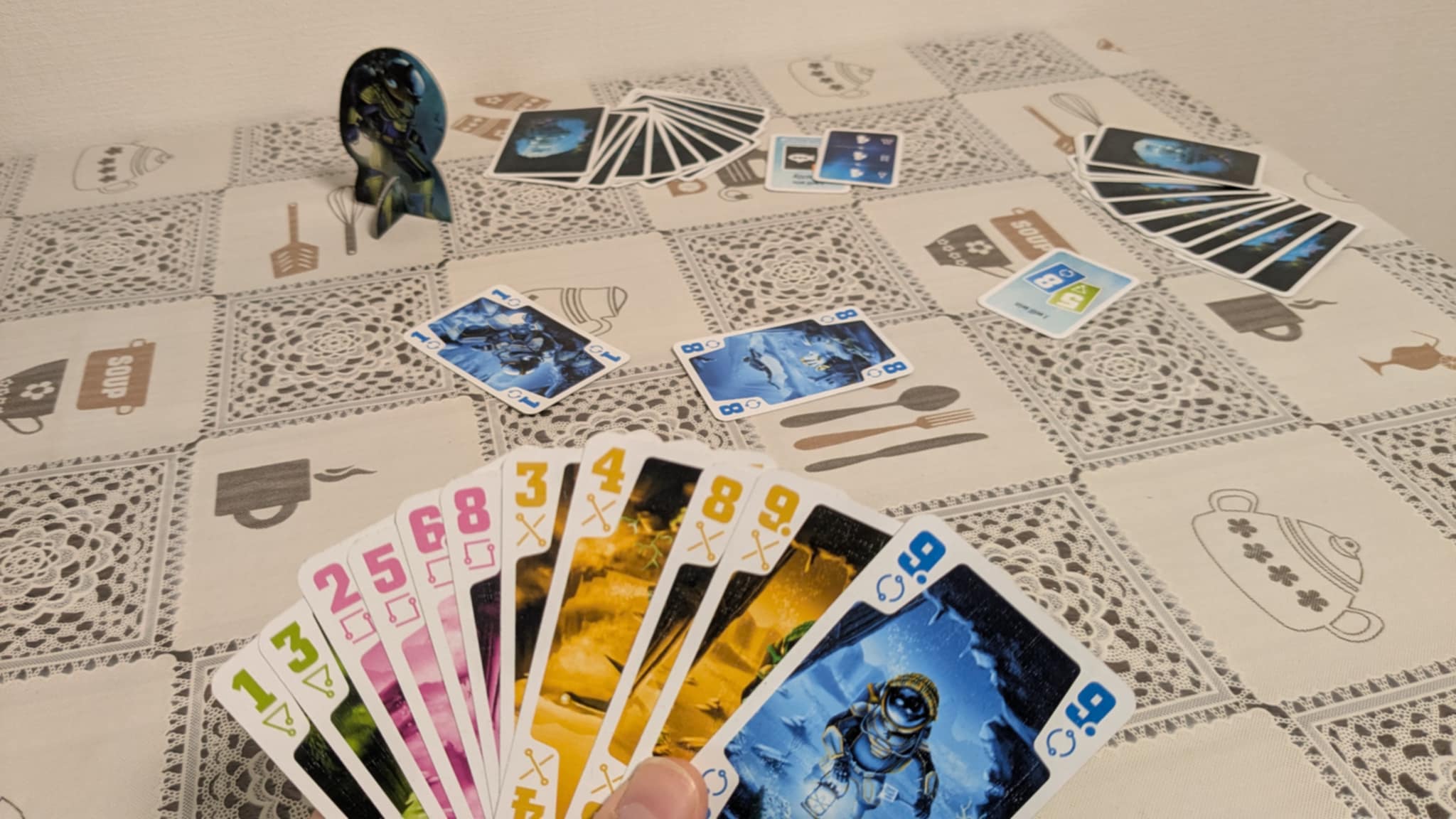
Strategic Use of the Communication Token
Me: Captain, those missions already sound tough enough—but doing all that in complete silence? How are players supposed to manage?
The Crew: Ah, glad you asked. Even in the crushing silence of the deep, we’ve got one lifeline. Each player gets a single communication token—just one per mission—to reveal a sliver of what’s in their hand.
Me: Just once per game is quiet tight isn’t it?
The Crew: Aye, once per mission. You place a card from your hand face up and put the token in one of three positions: top for your highest card in that suit, bottom for your lowest, or middle if it’s the only one you’ve got.
Me: So you’re not outright telling people what your hand looks like. Just giving them a clue?
The Crew: Exactly. It’s a whisper in the dark, not a shout. And let me tell you, this tiny rule adds massive tension. Use it at the right time, and it’s a guiding light through the murk. Use it wrong, and you’ve wasted your only lifeline.
Me: That seems incredibly subtle. How do players know when to use it?
The Crew: Just like everything else, you’ve got to read the game state, consider what’s already been played, and figure out when a little knowledge could steer the crew away from disaster. The token may seem small, but in the right moment, it’s everything.
Me: So even the tiniest mechanic carries weight in The Crew?
The Crew: Every move, every token, every silent second counts. That’s what makes the pressure so exhilarating.
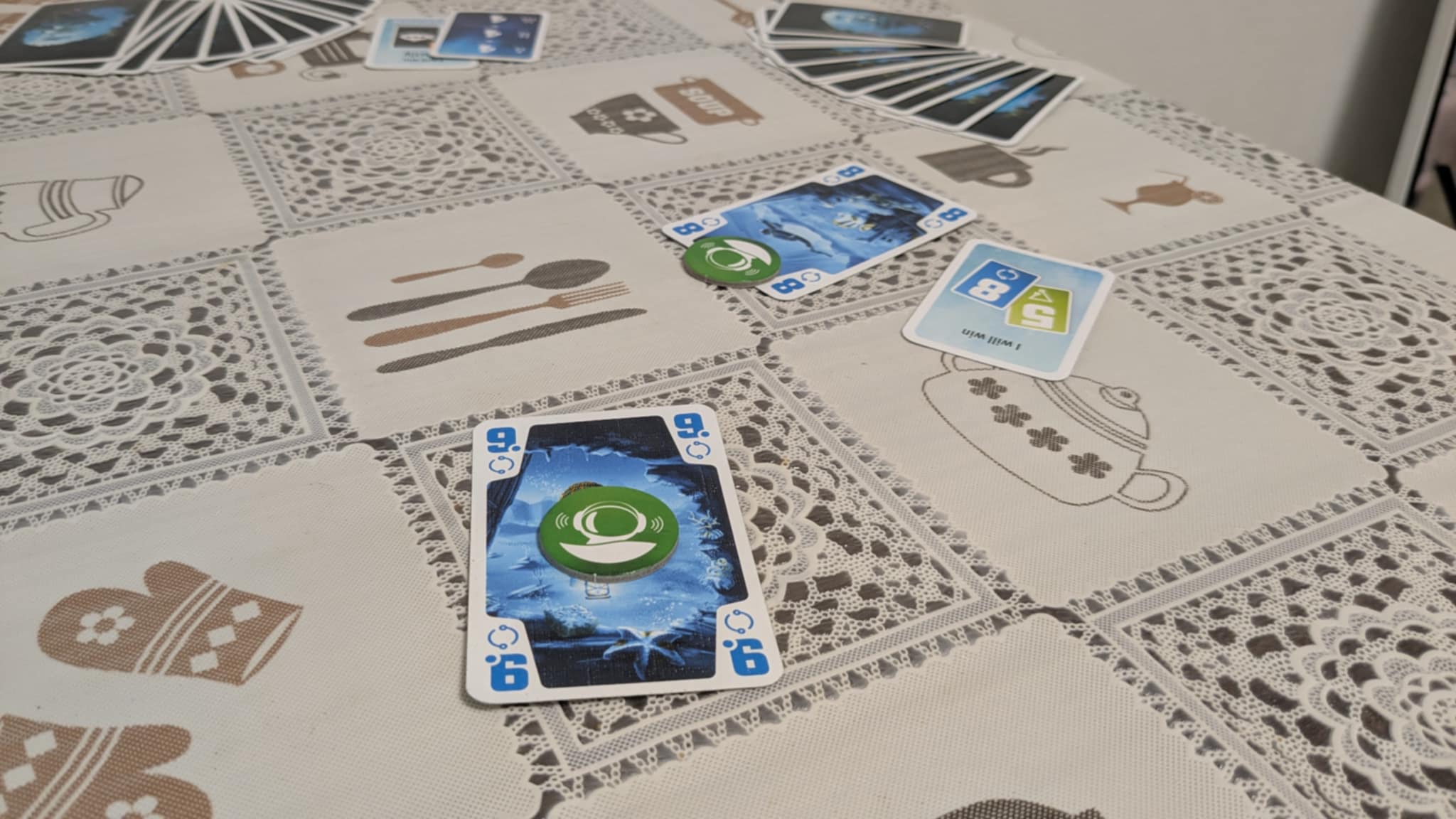
Tension and Texture: How The Crew Builds Its Mission Arc
Me: Let’s talk more about that tension. How does The Crew keep the pressure mounting throughout a mission?
The Crew: It’s all in the flow, sailor. Each mission begins with a full hand of cards, so things feel flexible and loose. But as soon as the first few tricks are played, your room to maneuver shrinks. Fewer cards, fewer options—and tighter missions.
Me: So the difficulty isn’t just baked into the tasks themselves?
The Crew: Not at all. It’s contextual. The exact same mission can feel breezy in one hand and brutal in the next, simply based on what players are holding. You might all laugh through it one round, then be sweating bullets trying to beat it the next.
Me: That variability must lead to some tough choices.
The Crew: Absolutely. A big part of the tension isn’t just cardplay—it’s group coordination. You’ve got to decide as a team: which task do we aim for first? Some tasks, once completed, can accidentally make another harder—or even impossible.
Me: That’s a rare kind of player interaction for a trick-taking game.
The Crew: It is. You’re not just playing your own hand—you’re playing with the entire team’s rhythm. Timing becomes everything. And the deeper you dive, the more precise you need to be.
Me: Sounds like it captures that feeling of going deeper into uncharted water.
The Crew: That’s exactly the feeling I aim for. With every turn, every mission, the pressure builds. But that’s where the excitement lives—just below the surface, where you’re one wrong step from disaster… or a perfect run.

Comparing Missions: The Crew vs. The Crew Quest for Planet 9
Me: Let’s talk about your older sibling—The Crew: Quest for Planet 9. How does your deep-sea adventure compare to that spacefaring predecessor?
The Crew: Ah, my starry-eyed sibling. The original Crew game paved the way with 50 missions that steadily ramped up in difficulty. Those missions were straightforward—mostly about winning specific tricks in a set order with minor twists. It was clean, accessible, and perfect for new recruits unfamiliar with trick-taking mechanics.
Me: But 50 missions is a lot. Did that become a bit much?
The Crew: Aye, that’s where the oxygen thinned. While the length was generous, it did feel a bit repetitive toward the end of the campaign. You’d seen most of what it had to offer by mission 35, let’s say.
Me: And what about you? How do you handle that kind of campaign structure?
The Crew: In the deep sea, we do things differently. I trimmed it to 30 missions but introduced scalable difficulty. Each mission has a target difficulty—say, level 5—and players build that with combinations of task cards. One round might use five level 1 tasks, another might combine a 4 and a 1. The variability is richer, the setup smoother, and the replay value higher.
Me: So fewer missions, but more flexibility?
The Crew: Exactly. I may be more compact, but I’m tighter, punchier, and let players tailor the mission challenge to fit their dive crew. Planet 9 had the vastness of space, but down here? Down here it’s dense, dark, and deliciously unpredictable.
Me: Sounds like both games are excellent, but they serve slightly different crews.
The Crew: That’s the spirit. One is your first voyage, the other is your return trip—deeper, bolder, and better equipped.
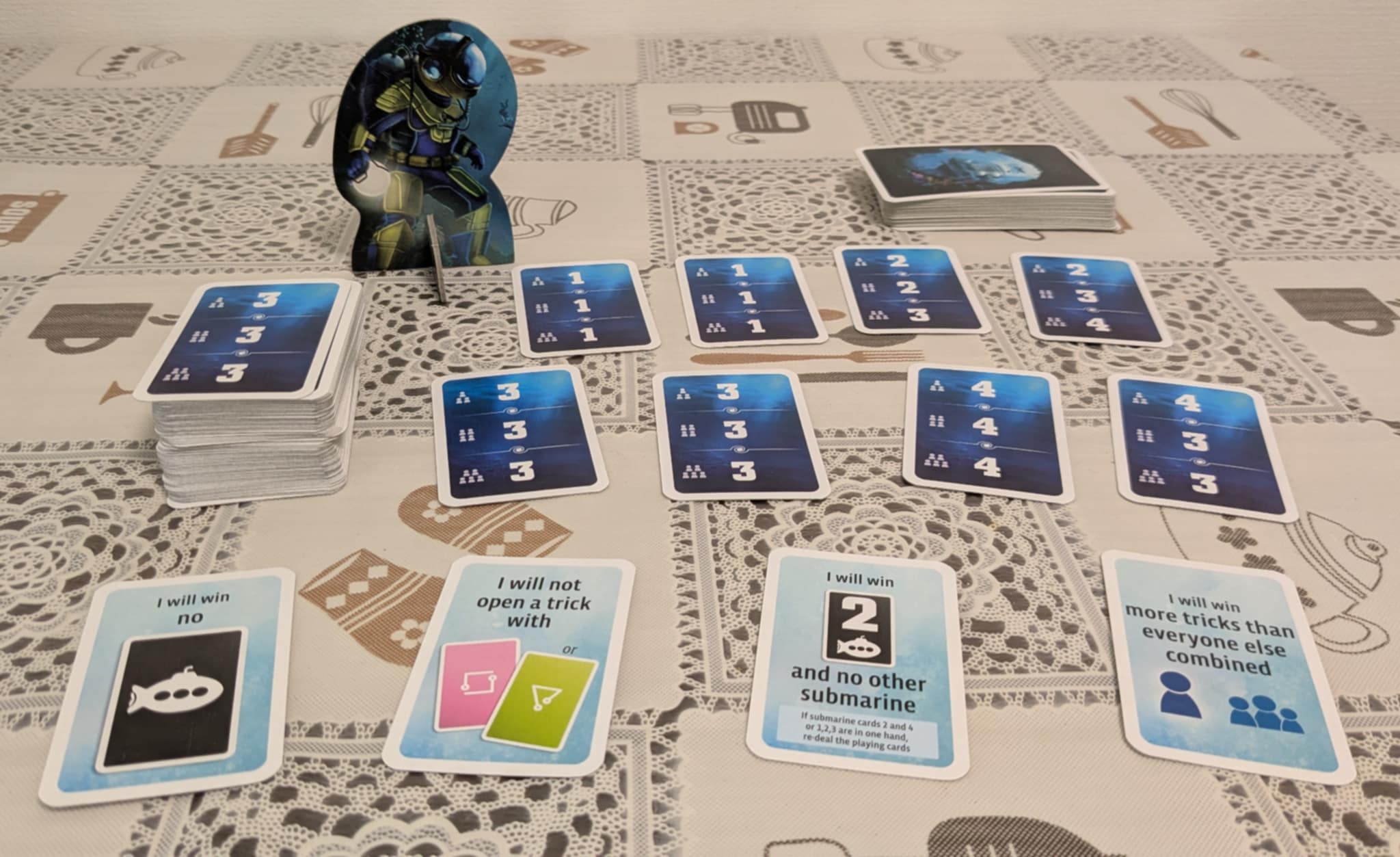
Streamlining the Mission: From Great to Masterpiece
Me: I think it’s safe to say—The Crew is a masterpiece. But like many sequels, your first outing wasn’t flawless. What were some of the small quirks in Quest for Planet 9?
The Crew: A fine observation, Captain. Quest for Planet 9 was indeed a strong start, but a couple of elements showed their seams. One was the mission setup—assigning tasks could feel just a touch too fiddly for how smooth and accessible the rest of the game was meant to be.
Me: And the missions themselves?
The Crew: They had variety, sure. But many leaned on similar structures—win this card, then that one, often in order. The repetition didn’t spoil the fun, but after dozens of missions, the tension started to wear thin. Nothing major, just something that seasoned crews began to notice.
Me: And that’s where Mission Deep Sea came in and cleaned things up?
The Crew: Exactly. Being the second entry gave me the chance to evolve. Instead of a static mission list, Deep Sea uses task cards with difficulty values. That lets players assemble missions to suit their preferred challenge, trimming down setup time and boosting replayability in one clever move.
Me: Some say the unique, random nature of the tasks makes this version trickier for newcomers. Fair point?
The Crew: It’s true. The variability can be daunting at first. But as a sequel, I wasn’t designed to teach trick-taking from the ground up. I assume players have dipped their toes already. For hobby gamers, this direction isn’t a drawback—it’s a natural and welcome progression.
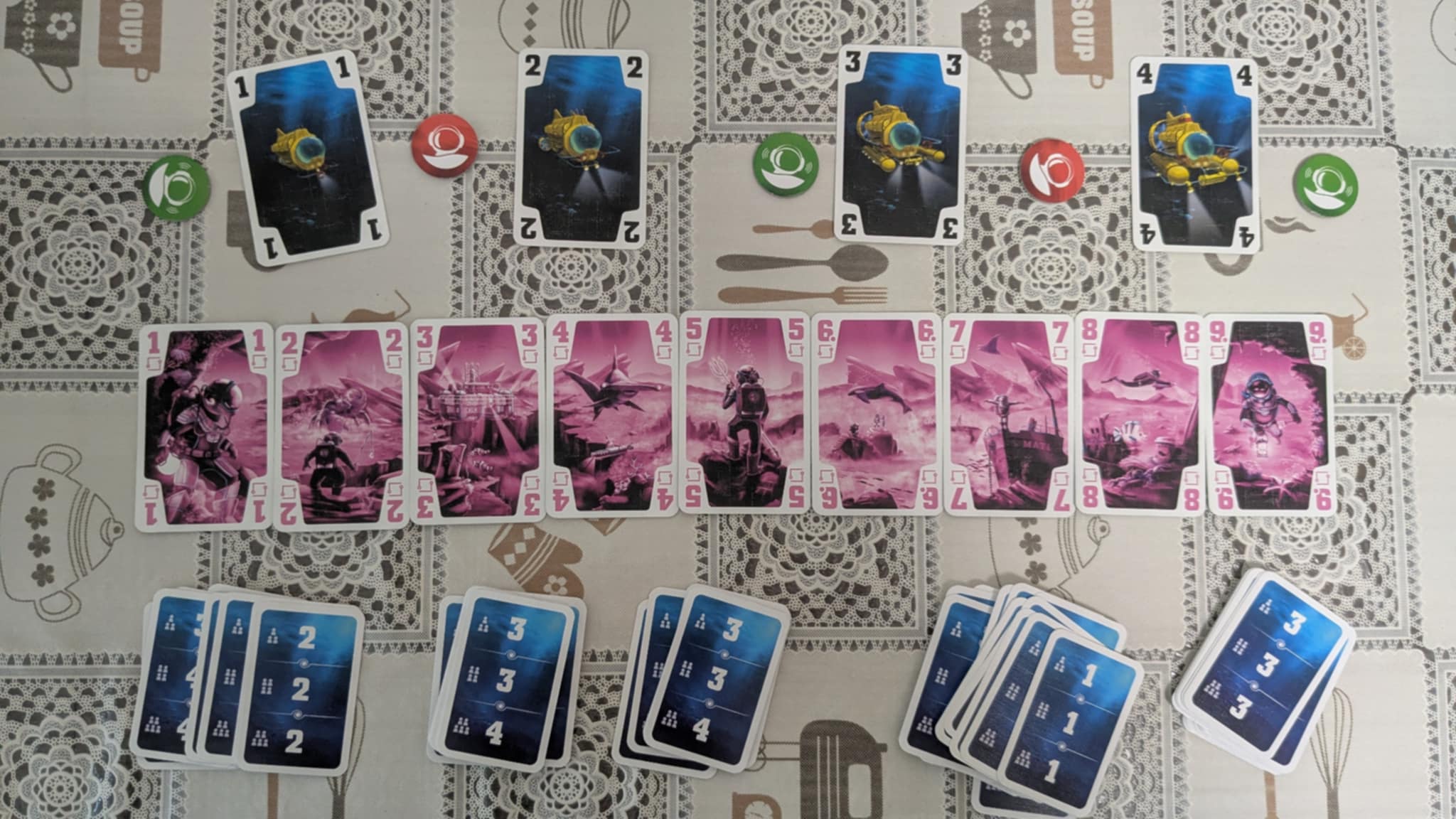
Final Verdict: A Timeless Modern Classic
Me: Well, Captain, I’ve played a lot of games in my time… but The Crew? You’re something else. A modern classic, no question. One of the greatest board games to surface in the past decade.
The Crew: You’re too kind. I just do my part—bringing teams together, one silent signal at a time.
Me: You’ve more than earned your reputation. Even now, years after your release, you feel fresh, unique, and packed with brilliantly tense fun. You’re simple to teach, but your depth keeps players coming back again and again. You’re the kind of game that grows with the crew at the table.
The Crew: That’s the dream. Whether it’s a rookie team taking on their first shallow-water mission, or a seasoned crew descending to the deepest depths, I want to offer something worth remembering.
Me: And you do. Every time. I can say, without hesitation, that I unreservedly recommend The Crew to anyone who wants to challenge their mind, strengthen their friendships, or just share some laughs through cardplay and clever timing. You’re not just a game—you’re an experience that makes people love their friends more.
The Crew: Thank you, Captain. That means the world. Until next dive.
Me: Fair winds and calm seas, my friend. You’ve more than earned your place in the board game hall of fame.
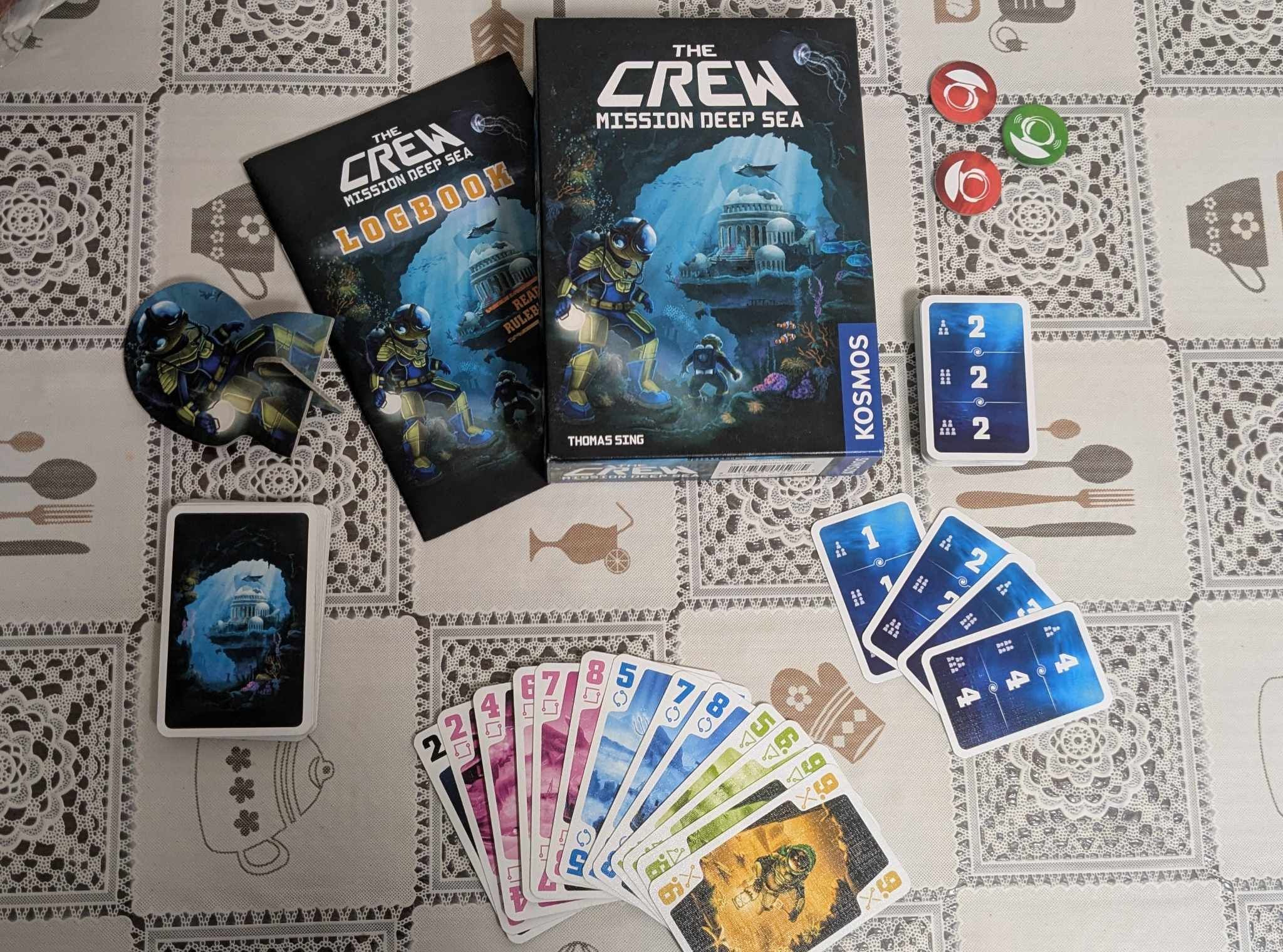
Conclusion
There are few experiences in board gaming as quietly exhilarating as The Crew: Mission Deep Sea. It redefines what communication means at the table, creating a space where players learn to listen not with ears, but with attention. It’s no surprise that this title has become a benchmark in cooperative and card game design.
Alternative Recommendations: Naturally, The Crew: Quest for Planet 9 is your next port of call. It’s a little friendlier for trick-taking beginners, with simpler missions and a steady introduction of challenges. For another game where players must express themselves without words, Mysterium Park is an exceptional visual deduction experience. Looking for small-box brilliance? Regicide and The Gang are tight, clever card games that turn limited communication into thrilling gameplay. If you’re leaning more classic and want a fuller cooperative system with broader player powers, Pandemic is still one of the genre’s gold standards.
Final Rating: 10/10
Pros:
- Brilliant use of trick-taking as a communication language
- Incredible depth that evolves with your group
- Dynamic, tense missions that build arcs and emotion
- A compact package with endless replay and bonding potential
Cons:
None. This is one of those rare gems that reminds us why we fell in love with board games in the first place.

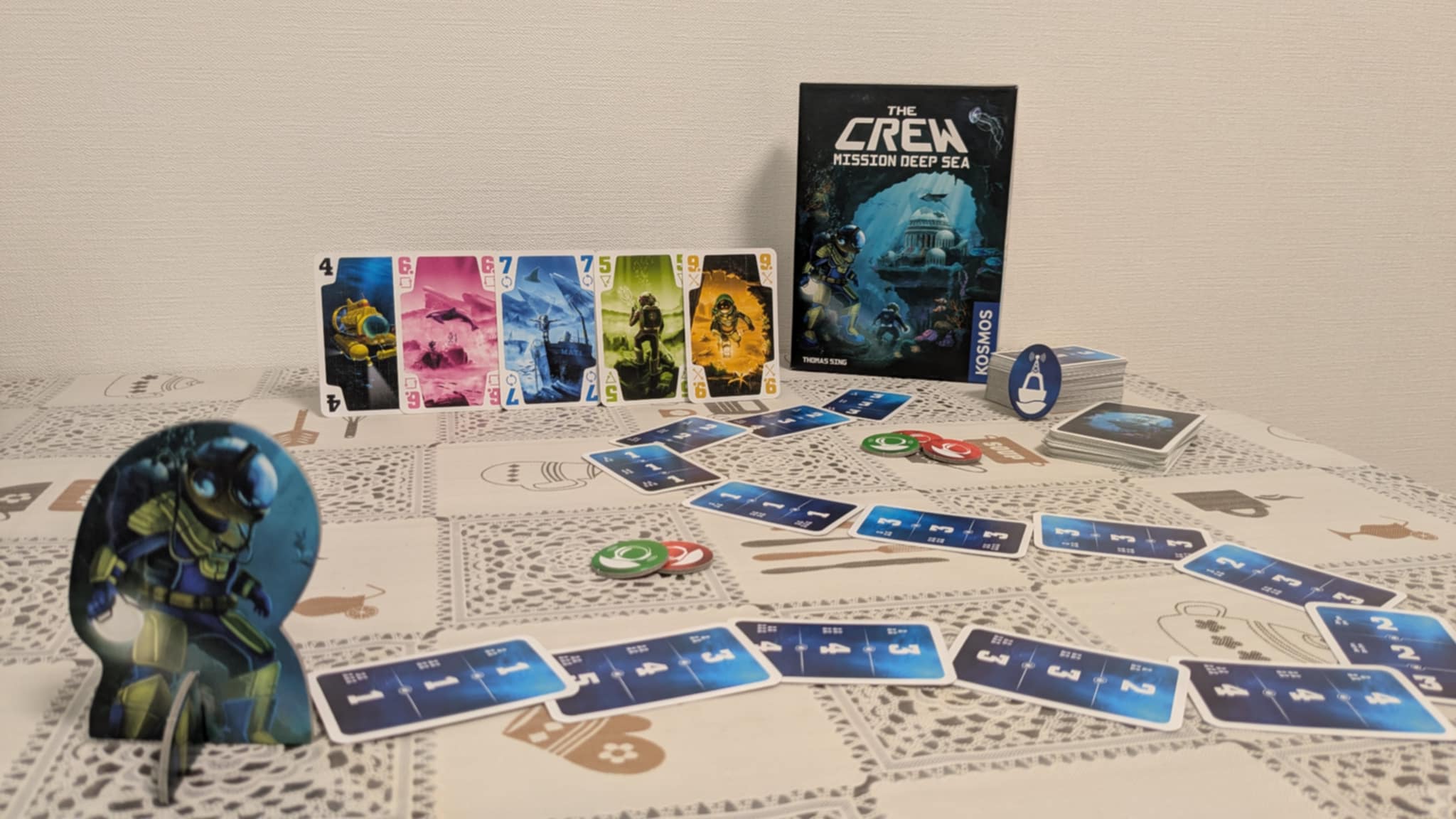
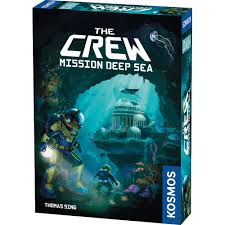
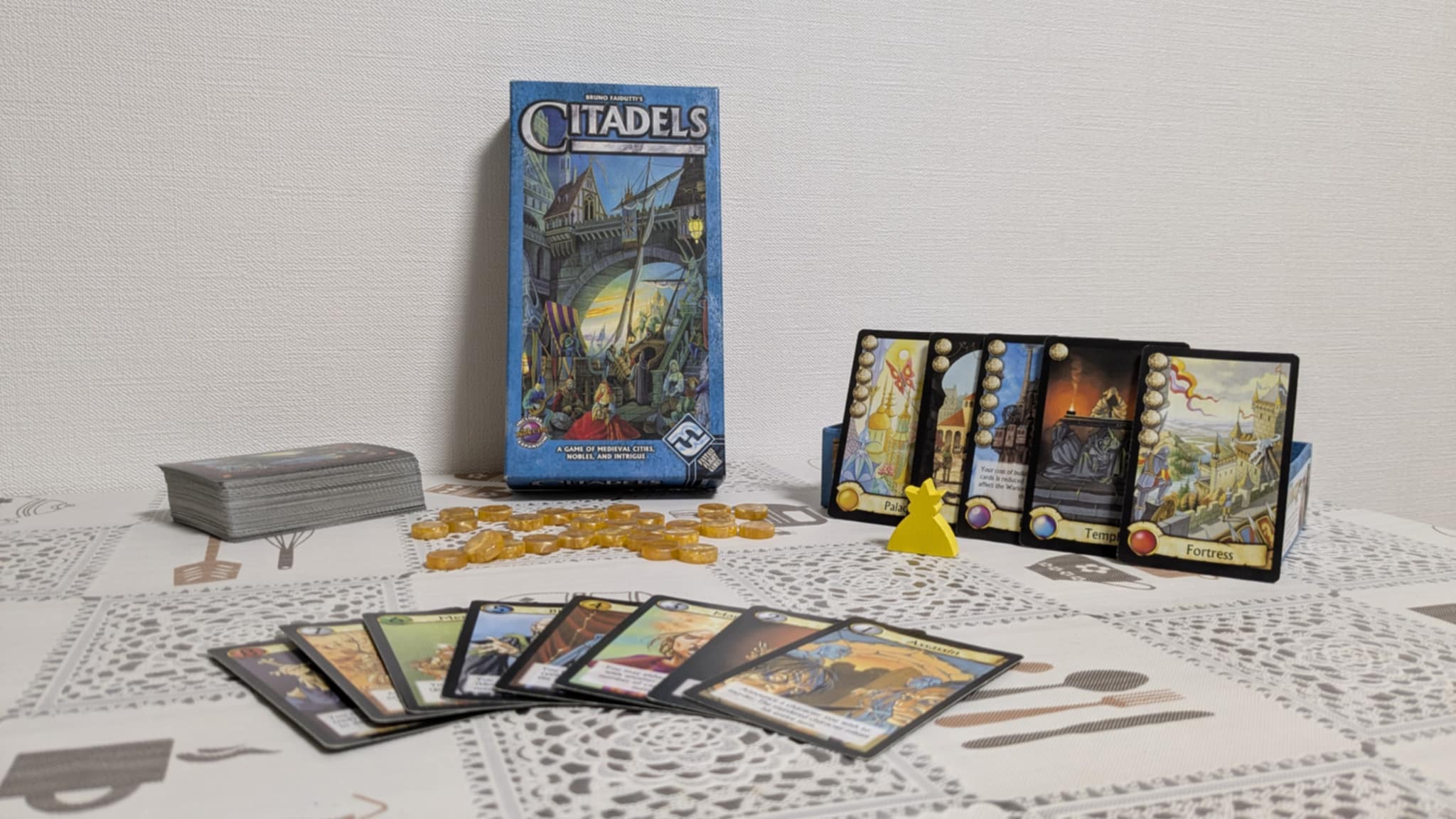

Leave a Reply